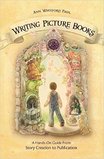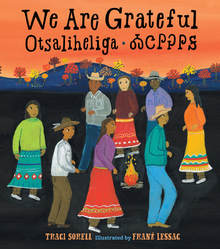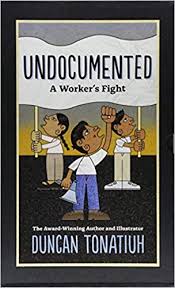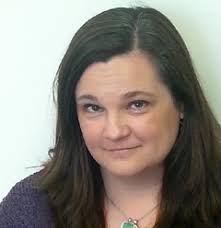 Hosted by Kelly Carey We are thrilled to welcome author Traci Sorell to 24 Carrot Writing. Traci’s debut picture book, WE ARE GRATEFUL: OTSALIHELIGA (Charlesbridge, 2018) received a starred review from Kirkus who called the book a “gracious, warm, and loving celebration of community and gratitude”. And more picture books are coming with AT THE MOUNTAIN BASE (Penguin/Kokila) in the fall of 2019 and POWWOW DAY (Charlesbridge) in the spring of 2020. Join us as we talk with Traci about her path to publication, her debut picture book, the story of how she found her agent, and how her ancestry as a member of the Cherokee Nation and her search for accurate books about her heritage fueled her writing journey. Welcome to 24 Carrot Writing, Traci! Congratulations on your debut non-fiction picture book WE ARE GRATEFUL: OTSALIHELIGA (Charlesbridge, Fall 2018)! Writers find inspiration and motivation to write from a variety of places. You have commented that you were motivated to write your book because you were struggling to find contemporary and culturally accurate books about Cherokee and indigenous people to share with your son. Can you talk about how this search turned into a desire to become an author? Wado (wah-doe)! “Thank you” in Cherokee. I am beyond thrilled for the publication of this book. I have an extensive picture book collection with many featuring Native American Nations, their cultures and traditional stories. After I had read those to my son, I thought why aren’t there more books showing Cherokee and other indigenous people in modern life. I found some, but a small amount compared to those centering life pre-1900. As a Native American Studies major in college, I most enjoyed studying history, law and politics of post-1900 life as experienced by Native Nations in the United States. After researching that there was plenty not told in children’s books (or textbooks for that matter), I realized I could be busy the rest of my life writing books and recruiting other Native creators to do the same. Your first foray into writing began as the author of legal codes, testimony for Congressional hearings, federal budget requests and grants. Once you decided to write a contemporary Cherokee story, what helped you find your picture book voice and what skills did you borrow from your grant writing days? I’m grateful for all the editing I received in my undergraduate, graduate and legal education. It helped my professional writing immensely. Writing starts out solitary, but ultimately it’s a collaborative process once it is to be shared with the world. The more trained eyes on a grant application, graduate thesis, legal code or brief and books for children, the better. I do a lot of self-editing before I give it to others to read, but my work always improves when great editors (critique partners, my agent, book editor) read it.  Also, I read a lot of picture books written in the last few years to learn what the market wanted. That helped me shape and edit my own voice to write sparse, lyrical text that sell in the marketplace. I benefitted from reading Ann Whitford Paul’s Writing Picture Books and connecting with published authors in my local KS-MO chapter of SCBWI who provided solid critiques and guided to me beneficial workshops to further develop my voice and craft. You have credited friends from graduate school and SCBWI for helping you find success in your writing journey. What is your networking advice to fellow authors? Networking is critical in this business. I’m a firm believer in doing homework and research on your genre(s), who publishes what you write, who else writes what you write and, if appropriate, who illustrates what you write. Then follow those folks on social media. If there’s an opportunity to meet them in person, introduce yourself, ask about their work, and strike up a conversation. It’s important to take time to make an authentic connection. There are so many generous people in this industry who will share their knowledge if you just ask. But don’t pester. Be respectful of their time and person. I would not be here without the support of others who have already established themselves in this industry. They helped me get the foundation I needed. Then I branched out from there to meet other creators across the nation. You were blessed with multiple offers for representation and with multiple offers for your book. How did you decide which offers to accept? I sold We Are Grateful: Otsaliheliga to Charlesbridge from the slush pile, which means I submitted it unagented and unsolicited. Three of the ten publishers I submitted to in December 2015 expressed interest. One of them was waiting for my answer when Karen Boss, Associate Editor at Charlesbridge, called. Their intern had read my manuscript and put in on her desk in March 2016. I had hoped that I would hear from them because they published Itse Selu: Cherokee Harvest Festival over twenty years ago. That picture book features Cherokee and English words in the text like my manuscript, and including the language is important to the story and to me personally. Charlesbridge still has that picture book in print, which also impressed me. I want We Are Grateful: Otsaliheliga to have that kind of longevity and publisher support. As for getting an agent, that process took longer. When I initially tried to query agents before and after that sale, I kept hearing, “Well, if you also want to write middle grade, get back in touch after you have a novel done.” I wanted someone to be enthusiastic about what stories I had ready to submit, which were all picture books, and not after my middle grade novel was ready. So I took a little time off. At the end of summer, I queried a few more agents. The universe must have shifted in the meantime as I received two offers of representation on the same day! When I spoke with Emily Mitchell, Wernick & Pratt Literary Agency, I knew that we would be a good fit. Her prior background as a senior editor and contracts manager at Charlesbridge met my preferred criteria of a having an editorial agent. She reps fiction and nonfiction across all genres. Exactly what I was looking for! In October 2013, I heard Emily present at the Oklahoma SCBWI conference—the first writing conference I ever attended. I wasn’t ready though at that time to be the client she was looking for; but, by the time I queried her three years later, I felt that I was. We’re a good team, both of us know our roles in this partnership. I’m very grateful. What do you wish to accomplish with WE ARE GRATEFUL: OTSALIHELIGA?  I have a couple of hopes. First, I hope that Cherokee children will enjoy seeing their contemporary culture reflected in the book and want to learn and do all the things featured in the book, including speaking our language (if they don’t already). For other children, I hope it provides them a window into a culture they may not be too familiar with because the Cherokee and other tribal nations are mostly invisible in modern U.S. culture. We’re still here, yet most children aren’t taught that we exist after 1900—either in their own homes or at school. I hope the book helps all children think about their cultures and teachings, whether that be about gratitude or some other value, and how cultivating those could be helpful to them in navigating daily life. What is your dream for yourself as an author? I have many dreams. First, I want to continue improving and deepening my craft in every book. I would like to publish a board book, a novel-in-verse, and a graphic novel in addition to my other current projects. I like the challenge of figuring out the puzzle—what is the best word, structure, or format to use. There are so many stories untold that I’ll be busy the rest of my life, working on these. I also want to ensure that Native and other marginalized children in this country are no longer invisible and accurately represented in children’s literature. There are books published in this industry every year that have not done the work necessary to get it right. That needs to stop. It is incumbent upon everyone – writer, illustrator, editor, art director, sales, marketing, management – to examine what they are putting out in the world and asking if it is accurate, will this harm young readers, etc. With my graduate and legal training, I’m used to having my work critically examined. I always consult experts and have sources for why I’ve written what I have, why the world was constructed, or characters formed this way, etc. regardless of whether it is fiction or nonfiction. My dream is to help raise awareness in this industry for other creators to have that same approach to both fiction and nonfiction works for children. As a debut author, what have you found most rewarding and surprising about the experience? So many things have been rewarding and surprising. It’s all new to me because I don’t have any professional writers in my family. I’ve been most surprised by how generous people have been in the industry. Several friends who write for adults tell me their side of the industry generally isn’t as supportive as it is in children’s literature. I’m glad I’m where I am. Another rewarding aspect has been meeting fellow Native creators – writers and illustrators. It nourishes my soul. There really is a push to get more accurate books in the hands of children and teens, so I’m doing my part to recruit talented Native folks to work in the industry. I attend Kweli’s annual Color of Children’s Literature conference in New York City each spring. The conference brings together Native and POC writers and illustrators with agents and editors. Every year, the number of Native writers and illustrators attending grows. Most of us are from different tribal nations across the continent, so it’s great to get together. Usually it’s the only time many of us are in the same place. It’s magical. How have you approached marketing your debut book? What lessons have you already learned? I am grateful to be part of Epic Eighteen, a group of debut picture book authors and illustrators with books published in 2018. We have shared marketing tips, best deals for designing/purchasing book swag, and how to handle the logistics of marketing (soliciting interviews if necessary, referring each other to bloggers, etc.) when our main focus has been on our writing. This group has relieved a lot of my anxiety. I know there are also groups for debut novelists too. I would recommend being a part of such a group. While it’s not always possible (financially or logistically), one of the things I did and highly recommend is to visit the publisher’s office in person. I went to Charlesbridge’s office in early April. I sat down separately with the marketing and the sales staff. We talked about what they were doing, what I should be doing, and I found I had a lot of information about potential sources for press release distribution or locations for sales that are pertinent to a Native American focused book that they did not have on their list. We also established a closer working relationship because we spent that time together. I’d recommend at least trying to video conference with the staff so that you make that human connection. You’re all in the same community, working to make your book as marketable and successful as possible. So putting faces, names and personalities together is always a plus in my book. Ultimately though, you will be responsible for doing most of the legwork around marketing your book through social media, being interviewed on blogs, via radio, etc. At 24 Carrot Writing we are big on goal setting. Do you set detailed writing goals, broad yearly goals or do you fly by the seat of your pants? I do set writing goals. I don’t have a daily word count or anything like that. But I do keep a list of projects that I’m working on with a timeline of when I want each completed and moving on the next phase, i.e., what needs to be drafted, what is being revised and what is on submission. Then, I also keep a list of what I want to write further down the road. Sometimes I want to write something, but my knowledge base or skill set isn’t there yet to tackle the genre. So those projects go on that last list. I also have yearly goals. I’m learning to be gentler with myself because life intervenes a lot. I’m in the sandwich generation right now. My husband and I have a young son, and we also have parents that are needing more of our help. All of them are the priority over our careers. 2018 has been a particularly challenging year so far. I’m hopeful this upcoming book launch season will be a celebratory time, but I’ll also have time to get a few more projects out the door. Regardless of whether I hit my goals or not, the key for me is to keep the faith and create. October is 24 Carrot Writing’s Trick or Book Treat Party. Would you like to celebrate with us by sharing your favorite writing trick or tip or treating your fellow writers to a book recommendation?  There are many books I would love to recommend, but Undocumented: A Worker’s Fight by Duncan Tonatiuh and published by Abrams is one of my favorite picture books in 2018. The narrator is a Mixteco indigenous man from Mexico who comes to the United States after his father dies. He stays with his uncle and sends money back to his mother and siblings. I LOVE that this shows that so many undocumented people here are actually indigenous folks from elsewhere on the American continents! I haven’t seen that reality reflected in other picture books. Duncan tells a very accessible story for children about this man through the context of his workplace where he and his coworkers are exploited, his personal life and his growing empowerment to address the injustice. I just love it! Plus, the story is told via the Mixtec code format in an accordion style layout and concludes with a powerful Author’s Note. So beautiful. Get to your bookstore or library and check it out now. What is up next for you? With this debut book launch, I’ve got a lot of travel for book signings and school visits coming up this fall. I’m looking forward to spending time with children and sharing the book with them. This is what I’ve been looking forward to since I wrote the story. On the publication front, since I’ve signed with Emily, we’ve sold two picture books and some shorter works (poems, chapters, short stories) in anthologies. In fall 2019, my first fiction picture book, At the Mountain’s Base, illustrated by Weshoyot Alvitre (Tongva), will be published by Kokila, the newest imprint of Penguin Random House. Then in the spring of 2020, my second one, Powwow Day, illustrated by Marlena Myles (Spirit Lake Dakota/Mohegan/Muscogee Creek) will be published by Charlesbridge. I’ve got several other projects in the works that I’m eager to share with the world when I can. To learn more about Traci visit her website at www.tracisorell.com. To purchase a copy of WE ARE GRATEFUL: OTSALIHELIGA click on the button below: Wado Traci!
0 Comments
Leave a Reply. |
Peruse blogs for advice and tips from KidLit creatives.
Categories
All
Archives
April 2024
Click to set custom HTML
Click on the RSS Feed button above to receive notifications of new posts on this blog.
|


 RSS Feed
RSS Feed